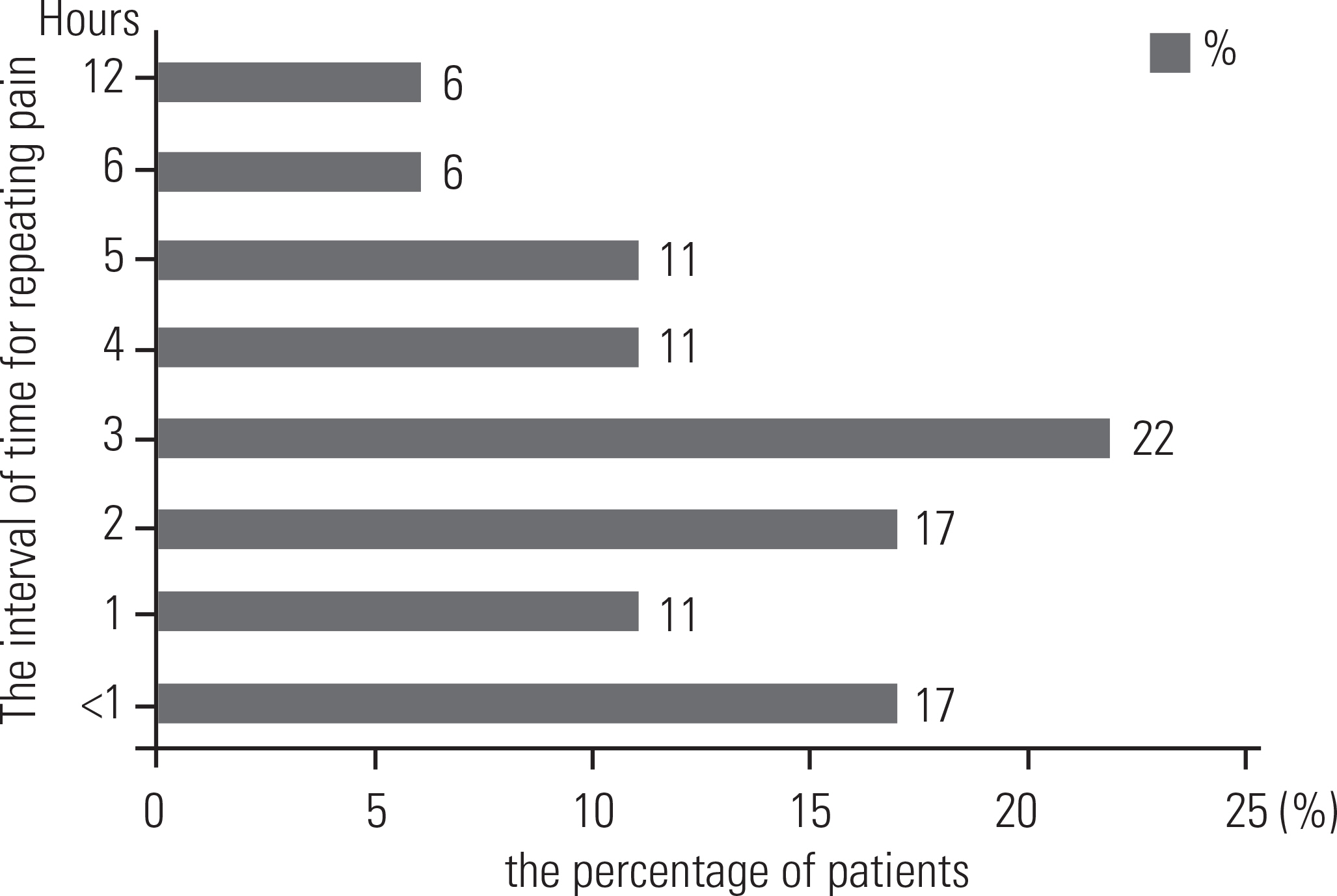J Korean Soc Spine Surg.
2018 Sep;25(3):91-98. 10.4184/jkss.2018.25.3.91.
Overview of the Management of Chronic Non-Cancer Pain in Patients with Spinal Disease
- Affiliations
-
- 1Department of Orthopedic Surgery, Kangbuk Samsung Hospital, Sungkyunkwan University School of Medicine, Seoul, Korea.
- 2Department of Orthopedic Surgery, Kangwon National University School of Medicine, Chuncheon, Korea. osnam@kangwon.ac.kr
- 3Department of Orthopedic Surgery, Chungbuk National University Hospital, Cheongju, Korea.
- 4Department of Orthopaedic Surgery, Inje University, Ilsan Paik Hospital, Ilsan, Korea.
- 5Department of Orthopedic Surgery, Chonnam National University Hospital, Chonnam, Korea.
- 6Department of Orthopedic Surgery, CHA University, CHA Bundang Medical Center, Korea.
- 7Department of Orthopedic Surgery, Inje University Haeundae Paik Hospital, Busan, Korea.
- KMID: 2421600
- DOI: http://doi.org/10.4184/jkss.2018.25.3.91
Abstract
- STUDY DESIGN: Cross-sectional, multi-center survey study.
OBJECTIVES
The objective of this study was to investigate the pain status, pain management methods, and pain experience after treatment among patients suffering from chronic non-cancer pain due to spinal disease. SUMMARY OF LITERATURE REVIEW: No thorough investigation of the current status of chronic non-cancer pain management in patients with spinal disease has recently been reported.
MATERIALS AND METHODS
We surveyed 330 patients with chronic non-cancer pain who visited spine clinics in Korea.
RESULTS
Prior to treatment, 86.7% of the patients had severe pain and 99.4% of the patients had taken oral analgesics for pain control. After treatment, the percent of patients with severe pain was reduced to 42.1%, and 52.4% of patients responded that they experienced intermittent pain. End of dose failure was experienced by 29.1% of patients, and 41.7% of patients experienced pain again 3-6 hours after taking analgesics. Furthermore, 8.2% of patients experienced breakthrough pain, and 29.1% of patients experienced pain that interfered with sleeping.
CONCLUSIONS
Many patients with chronic pain reported experiencing pain due to end of dose failure after medication. As the causes of chronic pain are complex, appropriate analgesics should be considered and selected for effective pain management.
MeSH Terms
Figure
Reference
-
1. Nam EJ. Treatment and approach to patients with chronic pain. Korean J Med. 2007 Aug; 73(2 Suppl):794–805.2. SNU HQ Center. Principles and methods of chronic pain management. 2015 Jan 21. [updated 2015 Dec 09; cited 2018 Mar 28]. Available from: http://hqcenter.snu.ac.kr/archives/jiphyunjeon/%eb%-a7%8c%ec%84%b1%ed%86%b5%ec%a-6%9d%ea%b4%80%eb%a6%ac%ec%9d%98-%ec%9b%90%ec%b9%99%ea%b3%bc-%eb%b0%a9%eb%b2%95?pnum=0&cat=100.3. Park JC, Choi YS, Kim JH. Current pharmacological management of chronic pain. J Korean Med Assoc. 2010 Sep; 53(9):815–23. DOI: 10.5124/jkma.2010.53.9.815.
Article4. Gallagher RM, Welz-Bosna M, Gammaitoni A. Assessment of Dosing Frequency of Sustained-Release Opioid Preparations in Patients with Chronic Nonmalignant Pain. Pain Med. 2007 Jan-Feb; 8(1):71–4. DOI: 10.1111/j.1526-4637.2007.00260.x.
Article5. Zeppetella G. Impact and management of breakthrough pain in cancer. Curr Opin Support Palliat Care. 2009 Mar; 3(1):1–6. DOI: DOI:10.1097/SPC.0b013e3283260658.
Article6. Ackerman SJ, Mordin M, Reblando J, et al. Patient-reported utilization patterns of fentanyl transdermal system and oxycodone hydrochloride controlled-release among patients with chronic nonmalignant pain. J Managed Care Pharm. 2003 May-Jun; 9(3):223–31. DOI: 10.18553/jmcp.2003.9.3.223.
Article7. Seo MS, Shim JY. Breakthrough Cancer Pain. Korean J Hosp Palliat Care. 2015 March; 18(1):1–8. DOI: 10.14475/kjhpc.2015.18.1.1.
Article8. Kim DY, Song HS, Ahn JS, et al. The dosing frequency of sustained-release opioids and the prevalence of end-of-dose failure in cancer pain control: a Korean multicenter study. Support Care Cancer. 2010 Feb; 19(2):297–301. DOI 10.1007/s00520-010-0825-x.
Article9. KH Jeong, Choi, JY Park, NS Kim, HY Park. Status of Chronic Pain Prevalence in the Korean Adults. Public Health Weekly Report. 2015; 8(31):728–34.10. Kim SK, Kim HS, Chung SS. Degrees of Low Back Pain, Knowledge of and Educational Needs for Low Back Pain in Patients with Chronic Low Back Pain. J Muscle Jt Health. 2017 Apr; 24(1):56–65. DOI: 10.5953/JMJH.2017.24.1.56.11. Chang YJ, Yun YH, Lee IG, et al. Factors of Patient Satisfaction with Pain Management in Cancer Patients. J Korean Acad Fam Med. 2003; 24(9):812–18.12. Park SY, Park JK, Yang JS, et al. Research on Administration Reality and Satisfaction Level about Taking Narcotic Analgesics. J Kor Soc Health-Syst Pharm. 2008; 25(4):295–303.13. Kwan TD. Management of acute & chronic pain. Korean J Med. 2011; 81(cho2):96–100.14. Jeon YH. Recent advances of pain treatment. J Kor Soc Health-Syst Pharm. 2013; 30(5):387–92.
- Full Text Links
- Actions
-
Cited
- CITED
-
- Close
- Share
- Similar articles
-
- Spinal Cord Stimulation in Pain Management: A Review
- Management of Spinal Cord Injury Pain with Small Divided Doses of Intravenous Ketamine
- Current strategy for chronic pain after spinal surgery
- Intractable Pain Management by Spinal Barbotage
- Multimodal management strategies for chronic pain after spinal surgery: a comprehensive review


